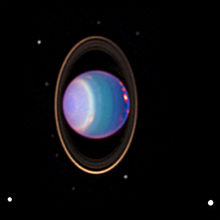Wikijunior:Solar System/Uranus
Uranus, the seventh planet from the Sun, was discovered by William Herschel on March 13, 1781.[1]

How big is Uranus?
[edit | edit source]
Uranus is 51,118 kilometers or about four Earths wide. It is the third widest and fourth heaviest planet in the Solar System.
What is the surface of Uranus like?
[edit | edit source]Uranus does not have a surface that you could stand on without going deep into the atmosphere. Under the atmosphere, there may be an even mixture of rock and ice.[2]
What are the rings around Uranus like?
[edit | edit source]Uranus has eleven rings. They are dark in colour and very hard to see. They were discovered by accident in 1977. Scientists were studying a bright star near Uranus. However, the star's light was blocked before and after it disappeared behind Uranus. From this, they figured out that Uranus has a ring system.[3]
What are its moons like?
[edit | edit source]
Uranus has 27 known moons, which places it third in the Solar System for number of moons. The five main ones are Miranda, Ariel, Umbriel, Titania and Oberon.[4]
Miranda is the smallest and closest of Uranus's major moons. It is mainly made of ice and rock. Miranda's surface has grooves, cliffs, and valleys. The moon was named after a character in The Tempest, a play by Shakespeare.[5]
Ariel
[edit | edit source]Ariel is made of rock and ice. Ariel has many valleys, but not many craters. Ariel was named after a character in the poem The Rape of the Lock by Alexander Pope. Ariel is also a spirit in The Tempest by Shakespeare.[6]
Umbriel is made of lots of ices and some rock. It is also the darkest of Uranus's major moons. Umbriel was named after a character in the poem The Rape of the Lock by Alexander Pope.[7]
Titania is the largest moon of Uranus. It is mostly ice and rock. The surface is covered with canyons. It was named after the Queen of the Fairies in A Midsummer's Night Dream, a play by Shakespeare.[8]
| The Solar System |
|
Introduction |
Oberon is the outermost of the major moons of Uranus. It is made of the same things as Titania. It has many craters. Some of them have white rays around them and dark crater floors. It was named after the King of the Fairies in A Midsummer's Night Dream.[9]
Other Moons
[edit | edit source]There are 13 tiny moons known to be orbiting Uranus inside Miranda's orbit. Nine more tiny moons are known to be in big orbits beyond Oberon's orbit.[10]
How long is a day on Uranus?
[edit | edit source]One day on Uranus is about 17.24 Earth hours long. Uranus spins on its side, maybe because of a big impact early in the history of the Solar System.[11]
How long is a year on Uranus?
[edit | edit source]One year on Uranus would be 30,708 days or 84 years on Earth.[12]
What is Uranus made of?
[edit | edit source]Unlike Jupiter and Saturn, Uranus is thought to be made mostly of rock and ice. The gases in its atmosphere are 83% hydrogen, 15% helium, and 2% methane. Other gases found in smaller amounts are ammonia, water, and methane.[13] Uranus' blue color comes from methane clouds, which absorb red light and reflect blue light.[14]
How much would Uranus's gravity pull on me?
[edit | edit source]If you were floating close to the cloud tops of Uranus, you would be pulled down with a force about 89% of Earth's gravity.[15]
Who is Uranus named after?
[edit | edit source]Uranus was named after Ouranos, the Greek name for the sky. Ouranos was the ancient Greek deity of the heavens, the earliest supreme God. According to Greek mythology, Ouranos was the husband and son of Gaia, Mother Earth.[16]
References
[edit | edit source]- ↑ http://www.nineplanets.org/uranus.html
- ↑ http://www.solarviews.com/eng/uranus.htm; http://www.nineplanets.org/uranus.html
- ↑ http://www.solarsystem.org.uk/uranus/
- ↑ http://nssdc.gsfc.nasa.gov/planetary/factsheet/index.html; http://www.nineplanets.org/uranus.html
- ↑ http://www.nineplanets.org/miranda.html; http://www.bbc.co.uk/science/space/solarsystem/uranus/miranda.shtml
- ↑ http://www.nineplanets.org/ariel.html; http://www.bbc.co.uk/science/space/solarsystem/uranus/ariel.shtml
- ↑ http://www.nineplanets.org/umbriel.html; http://www.bbc.co.uk/science/space/solarsystem/uranus/umbriel.shtml
- ↑ http://www.nineplanets.org/titania.html; http://www.bbc.co.uk/science/space/solarsystem/uranus/titania.shtml
- ↑ http://www.nineplanets.org/oberon.html; http://www.bbc.co.uk/science/space/solarsystem/uranus/oberon.shtml
- ↑ http://nssdc.gsfc.nasa.gov/planetary/factsheet/uraniansatfact.html
- ↑ Gierasch, Peter J., and Philip D. Nicholson. "Uranus." World Book Online Reference Center. 2004. World Book, Inc. http://www.worldbookonline.com/wb/Article?id=ar577720; http://www.nasa.gov/worldbook/uranus_worldbook.html
- ↑ Gierasch, Peter J., and Philip D. Nicholson. "Uranus." World Book Online Reference Center. 2004. World Book, Inc. http://www.worldbookonline.com/wb/Article?id=ar577720; http://www.nasa.gov/worldbook/uranus_worldbook.html
- ↑ http://www.nineplanets.org/uranus.html; http://www.solarviews.com/eng/uranus.htm
- ↑ http://www.solarviews.com/eng/uranus.htm
- ↑ Gierasch, Peter J., and Philip D. Nicholson. "Uranus." World Book Online Reference Center. 2004. World Book, Inc. http://www.worldbookonline.com/wb/Article?id=ar577720; http://www.nasa.gov/worldbook/uranus_worldbook.html
- ↑ http://www.nineplanets.org/uranus.html
